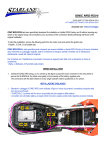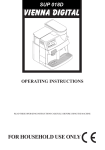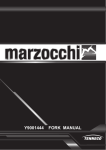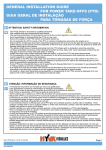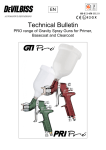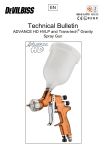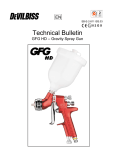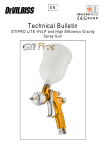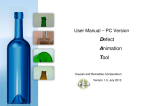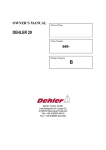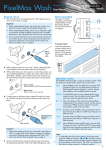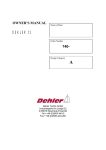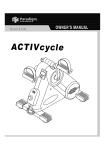Download 96 Mag Service
Transcript
SERVICE MANUAL 1 9 9 6 For Mag 21: 1993, 1994, 1995 and 1996 model years Mag 21SLTi: 1994 model year Mag 10: 1993 and 1994 model years RockShox, Inc. 1.800.677. 7177 INTRODUCTION This service manual describes how to service the following RockShox suspension forks: Mag 21: 1993, 1994, 1995 and 1996 model years Mag 21SLTi: 1994 model year Mag 10: 1993 and 1994 model years The ROCK SHOX Mag suspension fork is a sophisticated system. Care and patience should be used when servicing internal components. The damping units are oil-filled and pressurized, so a thorough understanding of the disassembly procedure, proper tools and a clean working area must be used to achieve correct performance and ensure that parts are not damaged. Use only genuine RockShox replacement parts. REQUIRED TOOLS COMMON HAND TOOLS: • Small tip external snap ring pliers • Small tip internal snap ring pliers • 19 & 22mm socket and ratchet or box end wrench • Torque wrench • Metric ruler, 150mm or longer • Precision calipers, 6 inch (optional) • 32 & 36mm headset wrenches • #1 phillips screw driver • 1-liter beaker or container for used fork oil • Safety glasses • Straight blade screwdriver • Bench vice SPECIAL ROCK SHOX TOOLS: 1 Upper tube clamping blocks (PN 70101) 2 Seal/lower bushing installer (PN 70103) 3 Seal puller (PN 70113) 4 Valve body tool (PN 70105) 5 Drop-out vice blocks (PN 70107) • Quadra bushing removal tool (PN 70106) • ROCK SHOX standard pump/air gauge (PN 20109—Not Shown) • RockShox needle (PN 56991) (no hole on side to tear air valve) MISCELLANEOUS: • High quality bearing grease (Judy Butter or Non-Lithium) • Medium strength thread lock (e.g. Loc-Tite 242) • ROCK SHOX fork oil (5wt. or 8 wt.) 1 2 3 4 Steerer Tube Damping Adjuster Knob Fork Crown Bolts (2 each side) Fork Crown Upper Fork Tube (w/dust boot) Fork Brace Fork Brace Bolt Brake Post Lower Tube page 1 5 R E M O VA L O F F O R K T U B E S F R O M F O R K C R O W N Note: It is not necessary to remove the crown/steerer assembly from the bike to service the damper units. 1. Disconnect front brake cable from brake lever. 2. Loosen fork crown bolts alternately to avoid putting too much clamping force on one bolt and potentially stripping the bolt head (4mm hex key). Figure 2A 3. Pull both lower fork tubes out of the crown with a slight rocking motion. (Fig. 2A) F O R K B R A C E R E M O VA L 1. Remove brakes as per manufacturer’s recommendations. 2. Remove both brake posts using an 8mm open end wrench. (Fig. 2B) 3. Remove both brace screws using a 4mm hex key. 4. Clean the exterior of both fork legs (use soap and water if necessary). Figure 2B DEPRESSURIZE FORK 1993 MAG 10 1993 MAG 21 1. MAG 10 (1993): Pry out upper tube dust cap from the side. (Fig. 2C) MAG 21 (1993): Remove air filler screw from the top of the air cap using a #1 phillips screw driver. (fig 2D) MAG 10 (1994) and MAG 21 (1994 and later): Pry off rubber dustcap from top of air cap. (Fig. 2E) 2. Insert a RockShox needle (PN 56991) through the exposed hole to depressurize the damper. (Fig. 2F) Figure 2C Figure 2D WARNING: POINT NEEDLE AWAY FROM YOURSELF AND OTHERS. 1994+ MAG 10/MAG 21 Figure 2E Figure 2F page 2 ! ▲ F O R K A I R C A P R E M O VA L 1993 MAG 10 1993 MAG 10 MAG 10 (1993): 1. Push the exposed aluminum air cap down into 10mm upper tube and remove the wire clip. (Fig. 3A) NOTE: DO NOT SCRATCH THE INTERIOR WALLS OF THE TUBE WHEN REMOVING THE WIRE CLIP. 2. Pull the air cap out of the tube with a 6mm bolt threaded into the center hole. (Fig. 3B) Figure 3A Figure 3B 1994 MAG 10 MAG 21 MAG 10 (1994): 1. Remove air cap by unscrewing it with an 8mm hex key. 2. Inspect the adjuster head O-ring for signs of wear or damage. Replace if necessary. (Fig. 3C) MAG 21 (ALL): 1. Turn air cap counterclockwise with a 19mm (’93 MAG 21) or 22mm (’94 and later MAG 21) with a socket or box wrench. (Fig. 3D) Figure 3C Figure 3D NOTE: DO NOT FORCE THE DAMPING ADJUSTER KNOB TO TURN WHEN REMOVING THE AIR CAP. THE SOCKET OR BOX WRENCH MUST NOT GRAB THE ADJUSTER KNOB WHEN REMOVING THE AIRCAP OR THE ADJUSTER ROD WILL BE DAMAGED. DRAIN OIL 1. Drain all oil by pumping unit upside down into a used oil receptacle. (Fig. 3G) PLEASE RECYCLE! 2. For oil change only, please see the section Fluid Level Setting. Figure 3G page 3 F O R K B O O T A N D D U S T W I P E R R E M O VA L 1. Remove fork boots by gently pulling up on them. 2. Inspect boots for wear or damage. Replace as needed. 3. Remove dust wiper by carefully prying up with a flat, blunt screw driver. (Fig.4A) (’93 MAG 10, ’93 MAG 21, ’94 MAG 21 and ’94 MAG 21 SLTi forks only!) 4. Inspect dust wiper for wear or damage. Replace as needed. Figure 4A NOTE: THE FOLLOWING MAG FORKS WILL HAVE FORK BOOTS INSTALLED AND NO DUST WIPERS: ’94 MAG 10, ’95 MAG 21, AND ’96 MAG 21. M A I N S E A L R E M O VA L Introduction: The upper and lower tubes are held together by the main seal snap ring. After removing the main seal snap ring, the main seal must be pulled out to separate the two tubes. 1. Remove main seal snap-ring using internal snap ring pliers. (fig 4B) 2. Extend upper and lower tubes to fully topped out position. 3. Place seal puller over tubes (tool #70113) with the larger end over lower tube. Figure 4B 4. Clamp upper tube in a vice with the vice blocks against the small end of the seal puller (tool#70101). 5. Unscrew seal puller by hand. For hard to remove main seals, refer to the instructions below. (fig 4C) 6. Upper and lower tubes can now be pulled apart by hand. (fig 4D) SPECIAL INSTRUCTIONS FOR HARD TO REMOVE MAIN SEALS: If unable to remove seals by hand, apply heat to lower tube at location of seal with a hot air gun or blow dryer. WARNING: DO NOT USE OPEN FLAME. Carefully, continue to unscrew puller. If necessary, use 32mm and 36mm headset wrenches on puller flats. Figure 4C NOTE: THE SNAP RING ON THE TOP-OUT SPRING CAN FAIL IF TOO MUCH FORCE IS USED TO REMOVE MAIN SEAL. PROCEED CAREFULLY AND SLOWLY. APPLY HEAT TO LOWER TUBE BEFORE ATTEMPTING TO USE 32MM AND 36MM WRENCHES. If the top-out retaining ring fails, the upper tube will separate from the lower tube and the seal, bushings, top-out spring and top-out retaining ring will remain in the lower tube. Grab the bushings and the main seal with one end of the Quadra bushing removal tool (PN 70106), slide the seal puller over the bushing removal tool shaft and attach the end of the bushing removal tool to a bench vice. Use the Figure 4C seal puller to pull the bushings and main seal straight out from the lower tube. An alternate method is to use a small, thin, flat-blade screwdriver to pry the main seal from the lower tube—being careful not to damage the lower tube. The bushings, spacer, top-out spring and top-out retaining ring should now slide out of the lower tube. Turn upside-down and tap the lower tube on a bench. page 4 ! ▲ ! ▲ U P P E R T U B E PA R T S E X P L A I N E D 1. Slide the seal, bushing washer, main seal O-ring, bushings, bushing spacer, and top-out sleeve off the upper tube. (Fig. 5C) NOTE: ONLY REMOVE THE VALVE BODY FROM THE UPPER TUBE IF IT NEEDS SERVICE OR REPLACEMENT, OTHERWISE IT MAY BE LEFT IN THE UPPER TUBE WHILE OVERHAULING THE FORK. Skip to Upper Tube Parts Assembly. Figure 5A FOR DISASSEMBLED FORKS WHERE THE TOP-OUT SPRING RETAINING RING FAILED, INSPECT SNAP RING GROOVE ON VALVE BODY AND REPLACE AS NEEDED. USE ONLY GENUINE ROCKSHOX REPLACEMENT PARTS. 2. Place inverted upper tube in clamping blocks (PN 70101) and bench vice. 3. Insert pins, on valve body tool (PN 70105), into holes on valve body. Figure 5B 4. Turn valve body tool (PN 70105) counterclockwise with a 19mm wrench. Apply downward force while applying torque to valve body tool to prevent tool from pulling out and damaging valve parts. (Fig. 5A) NOTE: IF SERVICE OF THE TOP-OUT SPRING IS NOT REQUIRED, THE FOLLOWING STEP ME BE SKIPPED. 5. Remove top-out snap ring from valve body using external snap ring pliers. The top-out spring and topout washer should now slide off valve body. (Fig. 5B) • 1993 MAG series forks (Mag 10 and Mag 21) have identical upper and lower bushings. The bushings may be identified by the 1.126" (28.60mm) outside diameter. • 1994 and later MAG series forks have different size upper and lower bushings. The upper bushing outside diameter is larger than the lower bushing. Because the difference between the outside diameter of the upper and lower bushings is very small, it is recommended that the upper bushing be marked to avoid confusion. The lower bushing may be identified by the 1.126" (28.60mm) outside diameter. The upper bushing may be identified by the 1.157" (29.39mm) outside diameter. For MAG series forks, the 1994 and later lower fork bushings are identical to the 1993 upper and lower fork bushings. Top-out Snap Ring Top-out Sleeve Lower Bushing Top-out Spring Upper Bushing Bushing Spacer Top-out Washer Valve Body Main Seal Seal O-ring Bushing Washer Figure 5C page 5 Dust Wiper Main Seal Snap Ring M A G 2 1 VA LV E PA R T S E X P L A I N E D 1. Screw adjuster rod all the way clockwise into valve body. 2. Remove E-clip from bottom end of adjuster rod using a small straight-blade screwdriver. (fig 6A) 3. Unscrew adjuster rod from valve body. 4. Remove valve spring snap ring using snap ring pliers. Figure 6A 5. Remove valve parts from adjuster rod. (fig 6B) 6. Inspect parts and replace as needed. Figure 6B Valve Body Rebound Plate Valve Spring Washer (plastic) Valve Spring (aluminum) E-clip Adjuster Rod Valve Plate Valve Spring Snap Ring Figure 6C ’ 9 3 M A G 1 0 VA LV E PA R T S E X P L A I N E D 1. Hold valve body with tool (PN 70105) and remove valve bolt with flat blade screwdriver. 2. Remove E-clip from valve bolt using a straight-blade screwdriver. (Fig. 6D) Figure 6D 3. The rebound washer, valve plate, valve spring, and spring washer will now slide off. 4. Inspect parts and replace as needed. Valve Body Rebound Plate (plastic) E-clip Valve Spring Washer (preload) Valve Plate Valve Spring Figure 6E page 6 Valve Bolt MAG COMPONENT INSPECTION • All 1993 MAG series forks were assembled with stiff valve springs (PN 44103). However, for 1994 and later MAG series forks, the valve springs were softened (PN 44306) to improve fork responsiveness. The valve springs are a tuning variable. Figure 7A • The 1993 MAG valve body had two intake port valves with a compression bleed hole drilled 0.028" (0.71mm). 1994 and later valve bodies (PN 42226) had four intake port valves with a compression bleed hole drilled to 0.040" (1.02mm). The intake port valves and the compression bleed hole are tuning variables. • Another change made for the 1994 and later MAG series forks were that the valve plate (PN 42327) was machined with a relief step of 0.005". Figure 7B 1. Check coating on inside of bushings and replace if scratched or worn (brassy-colored). Replace bushings as needed. (fig 7A) WARNING: BUSHINGS FROM 1993 REBUILD KIT WILL NOT WORK CORRECTLY AS UPPER BUSHINGS FOR 1994 & LATER FORKS! 2. Check upper tube for signs of nicks or scratches that could damage seal or inhibit proper seal function. Replace upper tube as needed. Figure 7C 3. Check all O-rings for evidence of tears, deformations or scratches. Check rebound plate for deformations or scratches. Replace as needed. (fig 7B) 4. Check main seal for deformations or scratches. Replace as needed. (fig 7C) Figure 7D Figure 7E NOTE: IT IS VERY RARE THAT A SEAL FAILS. THE PRIMARY CAUSE OF SEAL LEAKAGE IS DUE TO DIRT WORKING INTO THE LIPS OF THE SEAL OR A SCRATCHED OR DAMAGED UPPER TUBE AND DISRUPTING THE SEAL’S FUNCTION. IN MOST CASES, THEY MAY BE CLEANED AND REINSTALLED. PROPER MAINTENANCE AND CLEANING OF THE UPPER TUBE AND DUST WIPERS WILL PREVENT LEAKAGE. 5. Check top-out spring for correct free length. Measure spring from end to end. Minimum length is 0.827" (21.0mm). Replace as needed. (fig 7D) 6. Inspect fork brace at cable mount area for signs of damage from crashes or misuse. (fig 7E) NOTE: IF POSSIBLE, ADJUST THE HANDLEBARS TO HIT THE TOP FRAME TUBE BEFORE THE FORK CAN SWING AROUND AND THE CABLE MOUNT HITS THE DOWN TUBE. Figure 7F 7. Inspect lower tubes for signs of damage at the drop-out area. (fig 7F) Replace as needed. page 7 ! ▲ VA LV E A S S E M B LY MAG 21 Valve Body Rebound Plate (plastic) Valve Spring E-clip Adjuster Rod Valve Spring Washer (aluminum) Valve Plate Valve Spring Snap Ring Figure 8A 1. Slide the following parts onto adjuster rod in the following order: rebound plate, valve plate, valve spring, and valve spring washers. (fig 8A) 2. Install valve spring snap ring on the damper rod using external snap ring pliers. Place sharp side of snap ring away from valve spring washer. (fig 8B) Figure 8B WARNING: BE CAREFUL NOT TO OVEREXTEND VALVE SPRING SNAP RING WITH THE PLIERS. ! ▲ 3. Screw adjuster rod assembly completely into valve body. 4. Install E-ring on bottom of adjuster rod. 5. Slide top-out washer onto valve body, followed by top-out spring, and install valve spring snap ring (see fig. 9C) sharp side away from top-out spring (Fig. 8A) to retain the assembly. MAG 10 Valve Body Rebound Plate (plastic) Valve Body Valve Spring Washer (preload) Valve Plate Valve Spring Valve Bolt Figure 8C 1. Slide the following parts onto valve bolt in the following order: valve spring washer, valve spring, valve plate, and rebound washer. (fig 8C) 2. Install E-clip with sharp side of E-ring away from rebound plate. 3. Thread valve bolt assembly into valve body using a straight-blade screwdriver. Use medium strength threadlock and torque to 36 IN-LBS (3.3 Nm). WARNING: OVERTIGHTENING WILL BREAK THE VALVE BOLT. page 8 ! ▲ U P P E R T U B E PA R T S A S S E M B LY 1. Hold upper leg in vice with upper tube blocks (PN 70101). 2. Tighten valve body into upper tube, (the valve goes into end of tube with threads all the way to edge) apply three drops of medium strength threadlock to valve body threads. Torque valve assembly to 35 FT-LBS (48 Nm) using valve body tool and 19mm (3/4") socket with torque wrench. (fig 9A) Apply downward force while torquing to prevent tool from pulling out and damaging valve ports. Figure 9A 3. Slide top-out sleeve onto upper tube with shoulder away from top-out spring. (fig 9C) 4. Slide lower bushing onto upper tube followed by the bushing spacer, upper bushing, main seal O-ring, and main seal washer. WARNING: FOR 1994 AND LATER MAG FORKS, THE UPPER BUSHING HAS A LARGER OUTSIDE DIAMETER THAN LOWER BUSHING. PLACING BUSHINGS IN THE WRONG POSITIONS WILL DAMAGE UPPER TUBES. FOR IDENTIFICATION OF UPPER AND LOWER BUSHINGS, SEE UPPER TUBE PARTS EXPLAINED SECTION. ! ▲ 5. Gently press above assembly into lower tube using seal installer tool (PN 70103). (Fig. 9B) Figure 9B 6. Grease main seal inside and out. Place main seal over upper tube. NOTE: INSTALL MAIN SEAL WITH SMALL SPRING SIDE FACING TOWARD INSIDE OF FORK. PRESS SEAL INTO LOWER TUBE USING SEAL INSTALLER TOOL. (FIG. 9B) THE END OF TOOL WITH LARGER BORE SHOULD FACE THE SEAL. 7. Install main seal snap ring (sharp side up, see fig. 9C) into lower leg using internal snap ring pliers. WARNING: THE SNAP RING MUST FULLY ENGAGE GROOVE IN LOWER TUBE. IMPROPER INSTALLATION MAY ALLOW THE TUBES TO SEPARATE DURING USE. Top-out Snap Ring Top-out Sleeve Lower Bushing Top-out Spring Upper Bushing Bushing Spacer Top-out Washer Valve Body Main Seal Seal O-ring Bushing Washer Figure 9C page 9 Dust Wiper Main Seal Snap Ring ! ▲ FLUID LEVEL SETTING Introduction: The air spring of the ROCK SHOX MAG series forks works by compressing a volume of air. As the air compresses, the pressure rises, causing more force to be exerted against tubes. This force creates a progressive spring curve that resists bottoming. Changing the space of air inside the fork dramatically alters the spring curve. Since oil is non-compressible, the level of oil inside the fork can be set to create the optimal spring curve. The oil level is measured, rather than volume, to create the proper air space and spring curve. Changing fork oil viscosity will change the damping of the fork. A lower viscosity fork oil allows the fork to compress and rebound faster. RockShox 5 weight Racing Oil is recommended for most riders. Heavier riders (>180 pounds) may prefer the performance of RockShox 8 weight Racing oil, because larger compression and rebound forces will be generated and require higher damping. 1. Mount lower leg vertical in vice with vice blocks tools (PN 70107). (Fig. 10A) 2. Compress upper tube completely into lower tube. 3. Turn adjusting rod to full counterclockwise position, using an aircap or an old adjuster head. (Fig. 10B) 4. Add fork oil (for oil selection see Performance Tuning) to top of tube. 5. Slowly pump upper tube up and down fully until no air pockets are felt in the damping (approximately 10 times). It will be necessary to pull up against the top-out spring to reach full extension of assembly. NOTE: PULL UPPER TUBE UP SLOWLY AND CAREFULLY OR A VACUUM MAY FORM, CAUSING THE BOTTOM PLATE TO BECOME LOOSE. IF OIL IS VISIBLE IN THE DROPOUT HOLE, THE LEG MUST BE COMPLETELY DISASSEMBLED AND THE BOTTOM PLATE REINSTALLED. 6. Add or remove oil to obtain the correct oil level. To determine the oil level, measure the distance between top of upper tube and top of oil when upper tube is completely compressed. For oil level selection, see Performance Tuning. (Fig. 10A) Figure 10A 7. Install air cap: MAG 21 (All): When installing air cap, engage adjuster rod with bottom of adjuster head. Turn air cap clockwise with a 19mm (1993 MAG 21) or 22mm (1994 and later MAG 21 models) with a socket or box wrench. (Fig. 10B) WARNING: DO NOT FORCE DAMPING ADJUSTER KNOB TO TURN WHEN INSTALLING AIR CAP. THE SOCKET OR BOX WRENCH MUST NOT GRAB ADJUSTER KNOB WHEN INSTALLING AIR CAP OR THE ADJUSTER ROD WILL BE DAMAGED. Figure 10B MAG 10 1993 MAG 10: When installing air cap, lubricate O-ring with grease and slide air cap into upper tube past wire clip groove. (Fig. 10C) Install wire clip and compress upper tube to seat air cap. 8. Pressurize fork legs to 80-100psi for 1 hour, then lower to desired setting. 9. Grease dust wiper and install with small spring facing top of fork. 10. Install fork boots. Figure 10C NOTE: FORK BOOTS SHOULD BE INSTALLED FOR OWNERS WHO RIDE IN MUDDY CONDITIONS, OR WHO WANT TO EXTEND INTERVALS BETWEEN MAINTENANCE. page 10 ! ▲ F O R K I N S TA L L AT I O N I N T O C R O W N 1. Clean upper tube of all oil and set damping adjuster to the first index position (softest setting). 2. Insert upper tube 3mm above the top of crown. (Fig. 11A) 3. Turn upper tube to align #1 position on adjuster with slot on crown. (Fig. 11B) NOTE: ALL TITANIUM FASTENERS ON THE MAG 21 SLTi MUST HAVE ANTI-SEIZE OR LUBE ON THE THREADS DURING INSTALLATION. Figure 11A 4. Tighten crown bolts to 60 IN-LBS (6.8 Nm) in an alternating fashion. NOTE: INSTALL STEEL CROWN BOLTS WITH AMPLE MEDIUMSTRENGTH THREADLOCK. WARNING: DO NOT OVERTIGHTEN CROWN BOLTS. ! ▲ 5. Rotate lower legs forward, so fork brace mounting holes face front of bicycle. Install brake posts and bolts through fork brace. Figure 11B WARNING: TO AVOID DAMAGE TO MAGNESIUM THREADS WHEN INSTALLING FORK BRACE, PLEASE OBSERVE STEPS 6 & 7 CAREFULLY. ! ▲ 6. Use ample medium-strength threadlock on brake posts and fork brace bolts. The correct torque for all years and models of MAG series forks is only 60 IN-LBS (6.8 Nm) for brake posts and brake bolts. 7. When installing brakes, be certain that brake fastening bolt is not torqued beyond 60 IN-LBS (6.8 Nm) or damage to magnesium threads may occur. If threads are stripped out of magnesium tubes, they can be repaired with a M6 X 1 X 9 Helicoil thread repair kit. 8. Install brakes as per manufacturer’s specifications. 9. For a brake requiring a brake cable mount, route brake cable housing directly from brake levers to top of cable mount on ROCK SHOX fork brace. Do not route cable through stem or any other mounts or cable stops! A properly installed brake cable should be able to move freely up and down with the full travel of fork legs. Full travel for MAG 21 is 50mm (MAG 21 LT full travel is 63mm). It may be necessary to install a new brake cable and housing. Note: The distance from top of brake cable hanger to bottom of cable mount on ROCK SHOX fork brace must be a minimum of 12mm with the brakes applied. 10.Check Tire Clearance: Maximum tire size is 2.2" wide or 335mm radius. Be sure to check this radius whenever you change tires. Exceeding this maximum will cause tire to jam against crown when forks are fully compressed. A minimum tire clearance of 1/4" (6.4mm) is necessary. NOTE: TO OBTAIN THE REQUIRED CLEARANCE, UPPER TUBES MAY BE ADJUSTED IN CROWN. HOWEVER, DO NOT RAISE UPPER TUBES IN CROWN MORE THAN 3MM! (FIG. 11C) page 11 ! ▲ SL UPGRADE KITS Installation of the EA-70 upper tubes and SL aircaps 1. Complete the following sections located in this manual: REMOVAL OF FORK TUBES DEPRESSURIZE FORK FORK AIR CAP REMOVAL DRAIN OIL FORK BOOT AND DUST WIPER REMOVAL MAIN SEAL REMOVAL 2. Complete steps 1 through 5 in UPPER TUBE PARTS EXPLAINED. THE VALVE BODY IS TIGHTENED AT THE FACTORY ONTO THE STEEL UPPER TUBE WITH 35 FT-LBS OF TORQUE AND BLUE LOC-TITE. THEREFORE IT IS ON VERY TIGHT. TO AVOID DAMAGE TO BOTH THE VALVE TOOL AND THE VALVE BODY, IT MAY BE NECESSARY TO APPLY A PENETRATING OIL OR USE MILD HEAT TO LOOSEN THE THREADLOCK. APPLY DOWNWARD FORCE SO VALVE BODY TOOL DOES NOT WALK OUT OF VALVE BODY. ! ▲ 3. Clean old threadlock from threads of valve body, do not use Loc-Tite on EA-70 upper tubes. 4. Install valve body into new EA-70 Taperwall upper tubes. Turn to Upper Tube Parts Assembly, step 1, to finish installation. L O N G T R AV E L C O N V E R S I O N Required parts: Mag 10/Mag 21 Long Travel Kit (PN 59030) or Mag 10/Mag 21 Performance Tuning Kit (PN 59025) 1. Complete the following sections located in this manual: REMOVAL OF FORK TUBES DEPRESSURIZE FORK FORK AIR CAP REMOVAL DRAIN OIL FORK BOOT AND DUST WIPER REMOVAL MAIN SEAL REMOVAL 2. Complete steps 1 through 5 in UPPER TUBE PARTS EXPLAINED. THE VALVE BODY IS TIGHTENED AT THE FACTORY ONTO THE STEEL UPPER TUBE WITH 35 FT-LBS OF TORQUE AND BLUE LOC-TITE. THEREFORE IT IS ON VERY TIGHT. TO AVOID DAMAGE TO BOTH THE VALVE TOOL AND THE VALVE BODY, IT MAY BE NECESSARY TO APPLY A PENETRATING OIL OR USE MILD HEAT TO LOOSEN THE THREADLOCK. APPLY DOWNWARD FORCE SO VALVE BODY TOOL DOES NOT WALK OUT OF VALVE BODY. 3. Exchange the cross-country travel top-out sleeve (PN 53124) with a long travel top-out sleeve (PN 53123) in both legs. 4. Read Performance Tuning and Performance Settings and perform the recommended modifications. 5. Continue with instructions in Valve Parts Explained to finish installation. page 12 ! ▲ PERFORMANCE TUNING The standard RS settings are designed for use by riders weighing between 140 and 180 lbs. (65-80 Kgs), and riding on a variety of cross country-type conditions. When the MAG series forks will be used by riders outside of this weight range or for other applications, such as downhill racing, the following settings should yield greater suspension performance. But first, it’s best to know how the ROCK SHOX MAG series fork works. The Basics: RockShox MAG series forks are based on an air spring/oil damped suspension system. An air/oil suspension system is really two components working together at the same time—an air spring and an oil damper (shock absorber). Most modern suspension systems utilize some form of spring and damper mechanism. A car, for example, uses a steel coil or leaf spring and an oil damper. However, steel springs are much heavier than an air spring. For this reason, a lightweight air spring and oil damped suspension system is more appropriate for bicycles. Suspension works by allowing the wheel to quickly move up and down with the irregularities of the ground without moving the mass of the rider or vehicle with it. This means the wheel can stay on the ground, improving control and “ground feel” for the rider. The suspension should move as much as possible to follow the ground without bottoming out (hitting the end of its travel). Depending on the bump size and how fast it is hit, the suspension varies in firmness to prevent bottoming, but the spring and damper do it in different ways. The spring changes according to how much it is compressed, while the damping changes according to the speed of the force put into it (how fast it compresses). This combination means the suspension can sense whether the wheel hits a big or small bump, or how fast or slow, and adjust its firmness accordingly. The damping also has a second function of controlling the rebound (extension) action of the suspension. A spring alone will rebound at different speeds depending on how much it has been compressed, and this would make the suspension movement very unpredictable. The rebound damping allows the suspension to rebound at a predictable speed. The air spring stiffness, or spring rate, can be altered in many ways to suit the rider’s weight, terrain or riding style. It can be made stiff in the beginning of the travel to stay more extended on steep downhills where more weight is on the front end, or stiff at the end so it won’t bottom out over jumps or if the rider is very heavy. The damping can likewise be tuned. The damping can be adjusted so that the fork moves when travelling over small bumps, like washboards, yet can be firm to absorb a large bump hit at high speed. The fork can also be tuned to be rigid while pedaling by creating a minimum force threshold that must be overcome before the suspension can move normally. While all this may sound simple, the possible combinations are endless and many potentially bad performance side effects can arise from any change made to the spring or damping. So, to make tuning easier, RockShox has come up with the following selection of special settings that can be safely made to suit a particular rider’s needs (page 14). page 13 S TA N D A R D R O C K S H O X S E T T I N G S MAG 21 MAG 10 Air pressure: 38 – 42 Psi 38 – 42 Psi Oil height: 40 – 45 mm 45 – 50 mm Oil viscosity: SAE 5 wt (RockShox) SAE 5 wt (RockShox) Valve spring preload: 0 – .5 mm 0 – .5 mm Rebound bleed hole(s): none none Compression Bleed hole: .040" (1.0mm) Std .040" (1.0mm) Std Travel: Standard (46mm) Standard (46mm) PERFORMANCE SETTINGS CROSS COUNTRY SETTINGS LIGHT RIDER (less than 140lbs.) HEAVY RIDER (+ 180lbs.) MAG 21 MAG 10 MAG 21 MAG 10 Air pressure: 35 – 40 Psi 35 – 40 Psi Air pressure: 42 – 48 Psi 42 – 48 Psi Oil height: 45 – 50 mm 50 – 55 mm Oil height: 35 – 40 mm 40 – 45 mm Oil viscosity: SAE 5 wt (RockShox) SAE 5 wt (RockShox) Oil viscosity: SAE 8 wt (RockShox) SAE 8 wt (RockShox) Valve spring preload: 0 – .5 mm 0 – .5 mm Valve spring preload: .5 mm – 1.0 mm .5 mm – 1.0 mm Rebound bleed hole(s): none none Rebound bleed hole(s): none none Compression Bleed hole: 1.5 mm Standard (1.0mm) Compression Bleed hole: Standard (1.0mm) Standard (1.0mm) Travel: Standard (46mm) Travel: Standard (46mm) Standard (46mm) Standard (46mm) DOWNHILL SETTINGS For MAG 10/MAG 21 forks with Long Travel Kit (PN 59030) or Performance Tuning Kit (PN 59025) LIGHT RIDER (less than 140lbs.) HEAVY RIDER (+ 180lbs.) MAG 21 MAG 10 MAG 21 MAG 10 Air pressure: 38 – 42 Psi 38 – 42 Psi Air pressure: 42 – 50 Psi 42 – 50 Psi Oil height: 40 – 45 mm 45 – 50 mm Oil height: 30 – 35 mm 30 – 35 mm Oil viscosity: SAE 5 wt (RockShox) SAE 5 wt (RockShox) Oil viscosity: SAE 8 wt (RockShox) SAE 8 wt (RockShox) Valve spring preload: 0 – .5 mm 0 – .5 mm Valve spring preload: 0 – .5 mm 0 – .5 mm Rebound bleed hole(s): 2 X 1.0 mm 2 X 1.0 mm Rebound bleed hole(s): none none 2.0 mm Compression Bleed hole: 1.5 mm Compression Bleed hole: 2.0 mm Travel: Long Travel (60 mm) Long Travel (60 mm) Travel: AVERAGE RIDER (140–180lbs.) MAG 21 MAG 10 Air pressure: 40 – 45 Psi 40 – 45 Psi Oil height: 35 – 40 mm 40 – 45 mm Oil viscosity: SAE 5 wt (RockShox) SAE 5 wt (RockShox) Valve spring preload: 0 – .5 mm 0 – .5 mm Rebound bleed hole(s): 1 X 1.0 mm 1 X 1.0 mm Compression Bleed hole: 2.0 mm Travel: 2.0 mm Long Travel (60 mm) Long Travel (60 mm) page 14 1.5 mm Long Travel (60 mm) Long Travel (60 mm) WA R R A N T Y ROCKSHOX, INC. WARRANTS ITS FORKS FOR A PERIOD OF ONE YEAR FROM ORIGINAL DATE OF PURCHASE TO BE FREE FROM DEFECTS IN MATERIALS OR WORKMANSHIP. ANY ROCKSHOX FORK THAT IS RETURNED TO THE FACTORY AND IS FOUND BY ROCKSHOX TO BE DEFECTIVE IN MATERIALS OR WORKMANSHIP WILL BE REPAIRED OR REPLACED AT THE OPTION OF ROCKSHOX, INC. THIS WARRANTY IS THE SOLE AND EXCLUSIVE REMEDY. ROCKSHOX SHALL NOT BE HELD LIABLE FOR ANY INDIRECT, SPECIAL OR CONSEQUENTIAL DAMAGES. THE WARRANTY DOES NOT APPLY TO FORKS WHICH HAVE NOT BEEN PROPERLY INSTALLED AND ADJUSTED ACCORDING TO ROCKSHOX INSTALLATION INSTRUCTIONS. THE WARRANTY DOES NOT COVER ANY FORK THAT HAS BEEN SUBJECT TO MISUSE OR WHOSE SERIAL NUMBER HAS BEEN ALTERED, DEFACED OR REMOVED. THIS WARRANTY DOES NOT COVER PAINT DAMAGE OR MODIFICATIONS TO FORKS. PROOF OF PURCHASE IS REQUIRED. Warranty Repair IF FOR ANY REASON IT SHOULD BE NECESSARY TO HAVE WARRANTY WORK DONE, RETURN THE FORK TO THE PLACE OF PURCHASE. IN THE USA, DEALERS SHOULD CALL FOR A RETURN AUTHORIZATION (RA#) PRIOR TO RETURNING PRODUCT. PRODUCTS RETURNED FOR INSPECTION MUST BE SENT FREIGHT PREPAID TO: ROCKSHOX, INC. 401 CHARCOT AVE. SAN JOSE, CA 95131 408.435.7469 FAX 408.435.7468 CUSTOMERS IN COUNTRIES OTHER THAN THE USA SHOULD CONTACT THEIR DEALER OR LOCAL DISTRIBUTOR. page 15
















